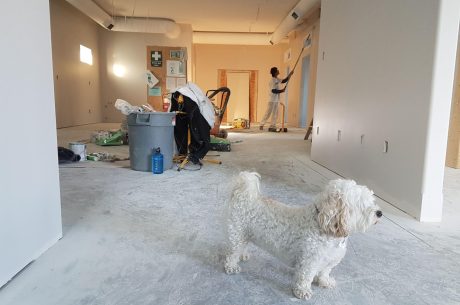Table of Contents
Water damage is one of the most common and expensive problems Florida homeowners face. Florida’s unique weather patterns—including heavy rainfall, high humidity, and hurricanes—make homes in the state more vulnerable to moisture intrusion, hidden leaks, and mold. For homebuyers, understanding how to spot water damage when buying a new home in Bradenton can protect you from purchasing a home with expensive, ongoing issues. Here’s a comprehensive guide to spotting water damage when buying a home in Florida.
7 Practical Steps on How to Spot Water Damage When Buying a New Home in Bradenton
1. Check Exterior Signs of Water Damage Specific to Florida Conditions
Foundation Cracks and Pooling: Look for cracks in the foundation or water pooling near the home. In Florida, poorly directed rainwater and frequent groundwater exposure can lead to foundation shifts or leaks.
Rust on Exterior Features: Given the salty air, especially near coastlines, rust can build up on metal fixtures, gutters, and window frames. Rusted components may indicate exposure to excessive moisture.
Inspect Gutters and Downspouts: Florida’s rainstorms demand efficient gutters to channel water away from the home. Look for sagging or disconnected gutters, and make sure downspouts are clear and extend far from the foundation.
2. Look for Interior Wall and Ceiling Stains
Check Baseboards for Swelling or Discoloration: Florida’s moisture-prone environment means baseboards are vulnerable to absorbing excess moisture. Swollen or discolored baseboards may indicate ongoing water exposure.
Yellow, Brown, or Black Stains: Heavy rains can lead to staining from leaks in roofs or windows. In the humid climate, these stains can develop quickly if there’s any water intrusion.
Inspect Ceilings Closely in Upper Levels: In multi-story homes, water damage can be hidden on upper levels from roof leaks. Stains on these ceilings may indicate poorly sealed roofing or areas impacted by hurricane force winds.
3. Test for Musty Odors or Mold Growth
Look Behind Furniture and Cabinets: In Florida, condensation can lead to mold growth even in hidden spots. Look behind cabinets, in closets, and around the perimeter of each room for any signs of mold or mildew. Mold can pose health risks and may be costly to remove if it’s hidden behind walls.
Inspect Air Conditioning Ducts: Central air is essential in Florida, but it can also be a source of water damage if ducts aren’t regularly cleaned and maintained. Musty smells coming from vents may indicate moisture and mold buildup.
4. Examine Windows and Doors Closely
Check Hurricane Shutters and Storm Doors: These are common in Florida and are vital in preventing water intrusion during storms. Make sure these protective measures are functional and in good shape.
Water Stains Around Window Frames: The humid and rainy Florida weather can lead to window leaks, especially in older homes. Look for peeling paint, rust, or wood rot around window sills.
Condensation Buildup: Consistent fogging or condensation on windows can indicate high indoor humidity levels, often a sign of water damage or poor ventilation.
5. Inspect Roof for Signs of Water Damage
Look for Roof Stains: In Florida, heavy rain and hurricane-force winds can damage roofing materials. Check the attic for water stains on insulation, joists, and roof decking.
Verify Roofing Age and Condition: Due to Florida’s storm-prone climate, roofs have shorter lifespans than in other regions. Ask the seller about the roof’s age, and inspect for signs of wear, such as missing shingles, sagging, or moss growth. This is one of the most overlooked steps when potential homeowners are brainstorming on how to Spot Water Damage When Buying a New Home in Bradenton.
6. Inspect the Flooring for Signs of Water Exposure
Moisture in Carpeting: Carpet can trap moisture, leading to mold and unpleasant odors. Walk barefoot to detect any damp spots or unusual smells in carpeted areas.
Tile and Grout Inspection: Tile is common in Florida homes, but loose or discolored grout can indicate moisture seeping beneath tiles.
Hardwood Floor Warping: High humidity in Florida can cause wood floors to swell and warp. If you notice gaps or uneven planks, there may be underlying water issues.
7. Ask for Maintenance Records and Home History
Check for Previous Renovations: Florida homes often undergo updates due to weather-related wear. Frequent renovations in bathrooms and kitchens might indicate past water damage repairs.
Review Flood Zone Information: Florida has designated flood zones, and insurance premiums can be higher for properties in high-risk areas. Inquire if the home has previously been affected by hurricanes or tropical storms and the effectiveness of the preventive measure. While figuring out how to Spot Water Damage When Buying a New Home in Bradenton may be a major step, it is equally important to understand the probability of incurring major and extensive repairs in the short term.
Request Information on Past Water Damage or Mold Remediation: Many Florida homes have dealt with water issues, so ask about any mold remediation and confirm with documentation.
Conclusion
Florida’s climate and geography make water damage a significant concern for homebuyers. By thoroughly inspecting both the interior and exterior of the property, checking for mold, and considering structural elements like windows, roofing, and foundation, you can avoid investing in a property with costly hidden issues.
While knowing How to Spot Water Damage When Buying a New Home in Bradenton is important, it should not necessarily deter you from going ahead with your purchase.
If you spot signs of water damage but still wish to proceed with purchasing the home, PuroClean of Bradenton is here to help restore it to a safe and comfortable condition. Our team of experts provides comprehensive water damage restoration services tailored to Florida’s unique climate challenges, from mold remediation to moisture removal and structural drying.
With PuroClean of Bradenton, you can move forward confidently, knowing that your investment is protected from further damage. Call 941-877-2288 today or fill this form to discuss how we can help restore and safeguard your new home.
You can also explore our social media here: Facebook, Instagram, LinkedIn



